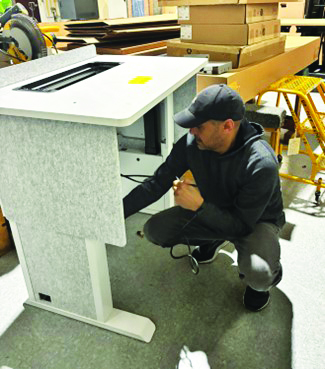Innovation — Unwired!

A DBA student sparks smarter design with customer-driven insights.
In the realm of audiovisual (AV) furniture design, Dr. Mohamed Gebril is a technical guru with several U.S. patents attesting to his expertise. But he never dreamed that he would become a marketing guru as well.
Typically, design engineers have had little direct interaction with customers. Sales negotiated specifications, and then products were designed to meet those requirements. But increasingly, Dr. Gebril wondered if we fully understood what customers wanted and needed.
His employer, Legrand AV (Middle Atlantic Division), supplies AV furniture, including lecterns, side racks, display stands, and collabora-tion tables, where AV equipment is mounted. A key strategic goal for the company is to acquire new customers.
Accordingly, while Dr. Gebril was taking a marketing course as part of his Doctor of Business Administration (DBA) program at Wilmington University, a light bulb lit up in his head when he learned about the Jobs-To-Be-Done (JTBD) approach to market research. His epiphany? Marketing is not just about advertising. The true essence of marketing is developing and providing an offering that solves customer problems better than competing products. Dr. Gebril viewed JTBD as a powerful tool for creating a granular understanding of customer needs, and he was excited about the real-life potential of applying this tool to help his employer grow its market share.
The JTBD process uses a combination of qualitative and quantitative techniques to develop a ranking of customer pain points. The process begins by identifying the combination of small tasks a customer needs to complete to accomplish a significant task. For example, for a purchaser to meet the organization’s AV furniture needs, that person would need to determine the types of furniture available from suppliers, evaluate their characteristics and pricing, select the supplier, prepare the order, pay the invoice, manage the placement of furniture when delivered, and conduct maintenance and repairs. By identifying which of these small jobs are pain points and creating offerings that address these issues, a supplier can gain loyal customers.

Dr. Gebril continues to utilize the JTBD toolbox to capture and analyze customers’ voices, guiding the development of two additional new products. But the story doesn’t stop there.
Dr. Gebril became passionate about using a JTBD analysis of the AV furniture market as the foundation for his DBA dissertation research. His employer also recognized the potential of utilizing this toolbox to gain a deeper understanding of the customer’s voice and agreed to serve as a sponsor for Dr. Gebril’s research.
Management expressed interest in gaining a deeper understanding of the needs of AV purchasers in the higher education market. Dr. Gebril consulted with four market-facing personnel and eight higher education purchasers to develop a list of 20 desired outcomes deemed relevant to the purchasing decision. These outcomes ranged from product characteristics to website design, sampling, and delivery issues.
A survey was then sent to higher education furniture purchasers, who were asked to rate the importance and their satisfaction relative to the 20 outcomes. Based on feedback from 28 respondents, Dr. Gebril identified the highest-opportunity pain points, where importance was high and satisfaction was low.
The results were surprising. Rather than the anticipated need for more attractive furniture, customers revealed that their primary concerns were durability and ergonomic design, which would accommodate all end users comfortably. This information led to a complete rethinking of a planned new product launch. With this new insight, it became clear that the acoustic material was a durability problem. Consequently, the acoustic material was replaced with high-pressure laminate wood material, and the words used to promote the product shifted from attractiveness to enhanced durability.
The new product is in its early launch stage, although one large customer has already planned to place an order and complimented the company for listening to and responding to the needs expressed in the survey. Following this initial success, Dr. Gebril continues to utilize the JTBD toolbox to capture and analyze customers’ voices, guiding the development of two additional new products. But the story doesn’t stop there.
The Voice of the Customer
There has also been a shift in the company’s culture. Dr. Gebril’s team has become a role model for other units, and listening to customers has been endorsed as a 2025 corporate initiative. The new product development vocabulary now extends beyond discussing specifications to inquiring about customer pain points and prioritizing them. To support this corporate refocus, Dr. Gebril is helping train other teams on how to identify and quantify desired outcomes before designing solutions.
“At Middle Atlantic, using the Jobs-To-Be-Done framework has already made a noticeable difference in how we approach our furniture solutions,” says Paul Dolynchuk, director of product management, Middle Atlantic Products, at Legrand AV. “It has helped us cut through the noise and focus on what our higher education customers are really trying to accomplish, making both our innovation and marketing efforts sharper and more relevant. What’s exciting is that our sister brands have seen the impact and are now applying the same methodology in their own spaces. It’s become a catalyst across Legrand AV for more focused, user-driven design.”
“I am passionate about bridging the gap between academia and real-life business challenges,” says Dr. Gebril. “The DBA program has played a key role in helping me turn theory into practice and leadership. By applying the JTBD framework, we gained deep insights about customer pain points across their holistic journeys, ranging from AV furniture ordering to delivery, maintenance, co-supplier interactions, and disposal.”
— Ruth Norman
Dr. Ruth Norman is a full professor at WilmU’s College of Business and Technology.
Want to read more in-depth stories? Explore our latest magazine articles.



